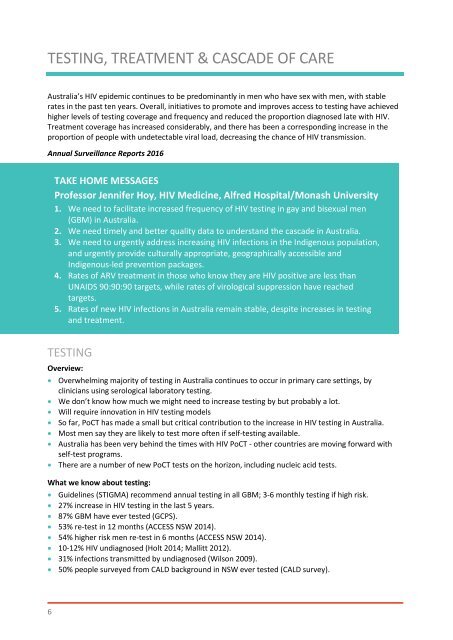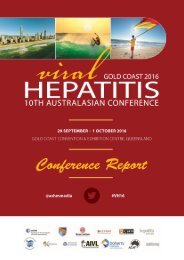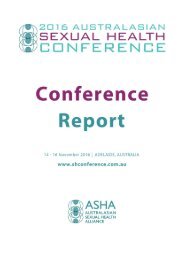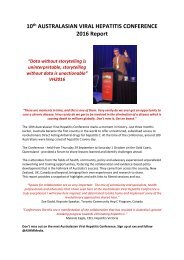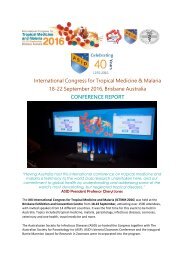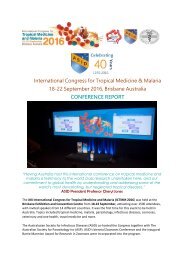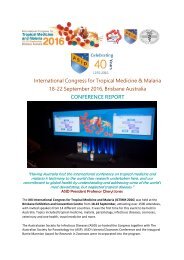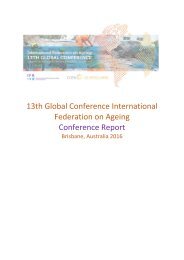AUSTRALASIAN HIV CONF REPORT 2016_FINAL
The Australasian HIV & AIDS Conference, run by ASHM, presents new and innovative research from across the Australasian HIV sector. Delegates include researchers, clinicians, policy makers, community organisations and activists. This 2016 Conference Report provides a collection of key learnings, with links to abstracts and presentations.
The Australasian HIV & AIDS Conference, run by ASHM, presents new and innovative research from across the Australasian HIV sector. Delegates include researchers, clinicians, policy makers, community organisations and activists. This 2016 Conference Report provides a collection of key learnings, with links to abstracts and presentations.
Create successful ePaper yourself
Turn your PDF publications into a flip-book with our unique Google optimized e-Paper software.
TESTING, TREATMENT & CASCADE OF CARE<br />
Australia’s <strong>HIV</strong> epidemic continues to be predominantly in men who have sex with men, with stable<br />
rates in the past ten years. Overall, initiatives to promote and improves access to testing have achieved<br />
higher levels of testing coverage and frequency and reduced the proportion diagnosed late with <strong>HIV</strong>.<br />
Treatment coverage has increased considerably, and there has been a corresponding increase in the<br />
proportion of people with undetectable viral load, decreasing the chance of <strong>HIV</strong> transmission.<br />
Annual Surveillance Reports <strong>2016</strong><br />
TAKE HOME MESSAGES<br />
Professor Jennifer Hoy, <strong>HIV</strong> Medicine, Alfred Hospital/Monash University<br />
1. We need to facilitate increased frequency of <strong>HIV</strong> testing in gay and bisexual men<br />
(GBM) in Australia.<br />
2. We need timely and better quality data to understand the cascade in Australia.<br />
3. We need to urgently address increasing <strong>HIV</strong> infections in the Indigenous population,<br />
and urgently provide culturally appropriate, geographically accessible and<br />
Indigenous-led prevention packages.<br />
4. Rates of ARV treatment in those who know they are <strong>HIV</strong> positive are less than<br />
UNAIDS 90:90:90 targets, while rates of virological suppression have reached<br />
targets.<br />
5. Rates of new <strong>HIV</strong> infections in Australia remain stable, despite increases in testing<br />
and treatment.<br />
TESTING<br />
Overview:<br />
Overwhelming majority of testing in Australia continues to occur in primary care settings, by<br />
clinicians using serological laboratory testing.<br />
We don’t know how much we might need to increase testing by but probably a lot.<br />
Will require innovation in <strong>HIV</strong> testing models<br />
So far, PoCT has made a small but critical contribution to the increase in <strong>HIV</strong> testing in Australia.<br />
Most men say they are likely to test more often if self-testing available.<br />
Australia has been very behind the times with <strong>HIV</strong> PoCT - other countries are moving forward with<br />
self-test programs.<br />
There are a number of new PoCT tests on the horizon, including nucleic acid tests.<br />
What we know about testing:<br />
Guidelines (STIGMA) recommend annual testing in all GBM; 3-6 monthly testing if high risk.<br />
27% increase in <strong>HIV</strong> testing in the last 5 years.<br />
87% GBM have ever tested (GCPS).<br />
53% re-test in 12 months (ACCESS NSW 2014).<br />
54% higher risk men re-test in 6 months (ACCESS NSW 2014).<br />
10-12% <strong>HIV</strong> undiagnosed (Holt 2014; Mallitt 2012).<br />
31% infections transmitted by undiagnosed (Wilson 2009).<br />
50% people surveyed from CALD background in NSW ever tested (CALD survey).<br />
6


